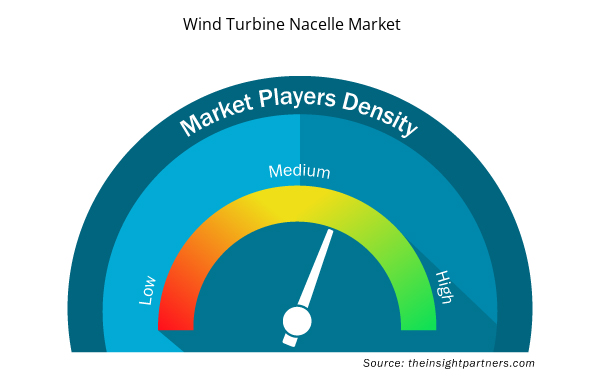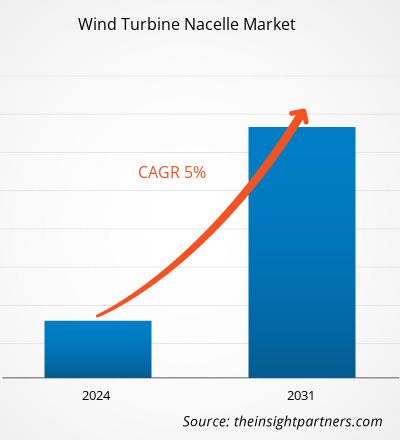風力タービンナセル市場規模は、2023年の316億5,631万米ドルから2031年には466億4,602万米ドルに達すると予測されています。市場は2023年から 2031年にかけて5.0%のCAGRを記録すると予想されています。再生可能エネルギーと持続可能性への注目の高まりは、風力タービンナセル市場の主要なトレンドであり続けると思われます。
風力タービンナセル市場分析
陸上および洋上風力発電所におけるさまざまな風力タービン部品の適用の増加は、再生可能エネルギー部門の発展を促進しています。さらに、洋上風力発電プロジェクトの増加は、発電における再生可能エネルギーの使用を促進しています。風力発電所への投資の増加と、環境汚染を軽減し、炭素排出量を削減するためのグリーンで持続可能なアプローチの普及により、風力タービンナセル市場は世界中で成長しています。
風力タービンナセル市場の概要
風力エネルギーは現在、世界中で力強い成長と発展を遂げています。発電に風力エネルギーを採用するという政府の取り組みが拡大していることから、風力タービンナセル市場に有利な機会が生まれています。洋上風力タービン用の浮体式風力技術の需要の高まりは、予測期間中に市場の成長に有利に働くと予測されています。この技術は、水深が非常に深い洋上風力タービンの開発に役立ちます。このコンポーネントは、風力発電所の高まる要件を満たすのに十分対応できるため、風力タービンナセル市場の見通しは引き続き良好です。再生可能で持続可能なエネルギー源としての風力エネルギーの受け入れは、長年にわたって強化されてきました。発電は風力エネルギーの主要な応用分野の1つであり、特に地政学的混乱の時期にエネルギー安全保障を高めるために使用されます。フランス、イタリア、英国などの国は、近隣諸国へのエネルギー依存を減らすために、代替エネルギー源として風力に主に焦点を当てています。
要件に合わせてレポートをカスタマイズする
このレポートの一部、国レベルの分析、Excelデータパックなど、あらゆるレポートを無料でカスタマイズできます。また、スタートアップや大学向けのお得なオファーや割引もご利用いただけます。
- このレポートの主要な市場動向を入手してください。この無料サンプルには、市場動向から見積もりや予測に至るまでのデータ分析が含まれます。
風力タービンナセル市場の推進要因と機会
持続可能なエネルギー源に対する需要の高まり
人口増加、都市化、急速な工業化などの要因により、発電用の持続可能なエネルギー源の需要が急増しています。風力発電は、増大するエネルギー需要を支えるために必要な電力の大部分を供給でき、適切なエネルギー供給に貢献できます。多くの国が、化石燃料への依存を減らし、安定したエネルギー供給を確保するために、代替の持続可能なエネルギー源を探しています。
世界の洋上風力発電容量は、中国と米国での新規設備と開発により、 2020年の34.4GWから2023年には64.3GWに急増しました。世界風力エネルギー協議会は、2050年までにネットゼロ目標を達成するための努力を続けています。ネットゼロ目標を達成するために、風力発電所の新規建設と拡張に世界中で多額の投資が行われています。さらに、風力発電所への資金援助の増加により、ナセル、ギアボックス、ローターブレード、発電機、ピッチシステム、タワーなどの風力タービン部品の需要が急増しています。
国際再生可能エネルギー機関(IREA)によると、風力エネルギーは、継続的な研究開発と運用コストの削減により、2000年以降急速に発展しています。たとえば、陸上風力発電の容量は2010年の178GWから2020年には699GWに増加し、洋上風力発電の容量は2010年の3.1GWから2020年には34.4GWに増加しました。国際エネルギー機関によると、2022年には風力による発電量は約265TWh増加し、 2021年から14%増加しています。このように、電力需要の増加とクリーンエネルギーへの好みの高まりにより、陸上および洋上風力エネルギープロジェクトの数が急増し、最終的に風力タービンナセル市場を牽引しています。
浮体式洋上風力発電プロジェクトへの投資増加
洋上風力発電所は、風速が高く、一貫性があり、陸地や人工物による物理的干渉がないため、陸上風力発電所よりも効率的であると考えられています。洋上風速は通常、陸上よりも高くなります。風速の小さな変化は、エネルギー生産量に大きな増加をもたらします。時速15マイルの風で稼働するタービンは、時速12マイルの風で稼働するタービンの2倍のエネルギーを生産できます。洋上風速が速いということは、はるかに多くのエネルギーを生成できることを意味します。洋上風速は陸上よりも一貫性があります。風の供給がより一貫しているということは、より信頼できるエネルギー源を意味します。陸上風力発電所と比較して効率が高いため、洋上風力発電所への投資が増加しています。2023年、英国に本拠を置くオクトパス・エナジーは、2030年までに洋上風力に200億米ドルを投資する計画を発表しました。2023年、米国政府は4番目の洋上風力プロジェクトを承認しました。この発表は、2030年までに30GWの洋上風力発電容量を導入するという米国の目標に向けた新たな一歩となった。
風力タービンナセル市場レポートのセグメンテーション分析
風力タービンナセル市場分析の導出に貢献した主要なセグメントは、プラント容量と展開タイプです。
- 発電所の容量に基づいて、風力タービンナセル市場は10MW未満に分類されます。
10MW以上。10MW以上のセグメントは2023年に大きな市場シェアを占めました。
- 展開タイプ別に見ると、市場は陸上と海上に分類されます。2023年には陸上セグメントが市場で最大のシェアを占めました。
風力タービンナセル市場シェアの地域別分析
風力タービンナセル市場レポートの地理的範囲は、主に北米、アジア太平洋、ヨーロッパ、中東およびアフリカ、南米/中南米の 5 つの地域に分かれています。
アジア太平洋地域は、風力タービンナセル市場を支配してきました。アジア太平洋地域の風力タービンナセル市場は、中国、インド、日本、オーストラリア、韓国、その他のアジア太平洋地域に分類されています。アジア太平洋地域は、政府の支援策と風力エネルギープロジェクトへの投資の増加により、市場をリードする地域の1つです。アジア太平洋地域の市場発展は、主に再生可能エネルギー産業への投資の増加、工業化と都市化の急速な成長、エネルギー需要の高まりに起因しています。中東とアフリカは、今後数年間で最高のCAGRで成長すると予想されています。
風力タービンナセル市場のニュースと最近の動向
風力タービンナセル市場は、重要な企業出版物、協会データ、データベースを含む一次および二次調査後の定性的および定量的データを収集することによって評価されます。以下は、風力タービンナセル市場の動向の一覧です。
- 2023年、シーメンス・ガメサとレプソルは、スペインの6つの風力発電所に合計200MWのSG5.0-145陸上タービン40基を供給する2つの新しい契約を締結し、商業関係を強化しました。この契約により、レプソルはシーメンス・ガメサの技術を採用した8つの風力発電所を所有することになり、合計324MWに達します。これら6つの風力発電所の設置は、これらの発電所を構成する40基のタービンのすべてのコンポーネント(タワー、ブレード、ナセル)がスペインの異なる工場で製造されるため、スペインの風力産業にプラスの影響を与えるでしょう。
- 2022年、GEリニューアブルエナジーとヒュンダイエレクトリックは、韓国の洋上風力市場へのサービス提供に向けて協力する取り組みの次のステップとして、戦略的パートナーシップ契約を締結したことを発表しました。最新の契約では、Haliade Xタービンに使用されるナセルと発電機を生産するための工場を韓国に設立する計画が概説されており、発電機部品の輸出にも韓国の拠点を活用する可能性があります。
風力タービンナセル市場の地域別分析
予測期間を通じて風力タービンナセル市場に影響を与える地域的な傾向と要因は、Insight Partners のアナリストによって徹底的に説明されています。このセクションでは、北米、ヨーロッパ、アジア太平洋、中東、アフリカ、南米、中米にわたる風力タービンナセル市場のセグメントと地理についても説明します。

- 風力タービンナセル市場の地域別データを入手
風力タービンナセル市場レポートの範囲
| レポート属性 | 詳細 |
|---|---|
| 2023年の市場規模 | 316億5,631万米ドル |
| 2031年までの市場規模 | 466億4,602万米ドル |
| 世界のCAGR(2023年~2031年) | 5.0% |
| 履歴データ | 2021-2022 |
| 予測期間 | 2024-2031 |
| 対象セグメント | 植物の種類別
|
| 対象地域と国 | 北米
|
| 市場リーダーと主要企業プロフィール |
|
風力タービンナセル市場のプレーヤー密度:ビジネスダイナミクスへの影響を理解する
風力タービンナセル市場は、消費者の嗜好の変化、技術の進歩、製品の利点に対する認識の高まりなどの要因により、エンドユーザーの需要が高まり、急速に成長しています。需要が高まるにつれて、企業は提供を拡大し、消費者のニーズを満たすために革新し、新たなトレンドを活用し、市場の成長をさらに促進しています。
市場プレーヤー密度とは、特定の市場または業界内で活動している企業または会社の分布を指します。これは、特定の市場スペースに、その規模または総市場価値と比較して、どれだけの競合相手 (市場プレーヤー) が存在するかを示します。
風力タービンナセル市場で事業を展開している主要企業は次のとおりです。
- 「シーメンス・ガメサ・リニューアブル・エナジーSA
- ゼネラル・エレクトリック・カンパニー
- スズロン・エナジー・リミテッド
- ノルデックス SE
- エネルコン株式会社
- ヴェスタス・ウィンド・システムズA/S
免責事項:上記の企業は、特定の順序でランク付けされていません。

- 風力タービンナセル市場のトップキープレーヤーの概要を入手
風力タービンナセル市場レポートの対象範囲と成果物
「風力タービンナセル市場」の規模と予測(2023〜2031年)レポートでは、以下の分野をカバーする市場の詳細な分析を提供しています。
- 対象範囲に含まれるすべての主要市場セグメントの世界、地域、国レベルでの市場規模と予測
- 市場の動向(推進要因、制約、主要な機会など)
- 今後の主な動向
- 詳細なPEST/ポーターの5つの力とSWOT分析
- 主要な市場動向、主要プレーヤー、規制、最近の市場動向を網羅した世界および地域の市場分析
- 市場集中、ヒートマップ分析、主要プレーヤー、最近の動向を網羅した業界の状況と競争分析
- 詳細な企業プロフィール
- 過去2年間の分析、基準年、CAGRによる予測(7年間)
- PEST分析とSWOT分析
- 市場規模価値/数量 - 世界、地域、国
- 業界と競争環境
- Excel データセット



Report Coverage
Revenue forecast, Company Analysis, Industry landscape, Growth factors, and Trends

Segment Covered
This text is related
to segments covered.

Regional Scope
North America, Europe, Asia Pacific, Middle East & Africa, South & Central America

Country Scope
This text is related
to country scope.
よくある質問
Siemens Gamesa Renewable Energy, S.A, General Electric Company, Suzlon Energy Limited, Nordex SE, ENERCON GmbH, Vestas Wind Systems A/S, Goldwind, Shanghai Electric, Hitachi Ltd., EEW Group are the key market players operating in the global wind turbine nacelle market.
Key role of wind power in future energy transition is anticipated to stimulate the wind turbine nacelle market growth in the coming years.
Regions such as Asia-Pacific, Europe and North America will boost the growth of the wind turbine nacelle market during the forecast period. This growth is owing to the rise in investment on construction of wind power plant facilities in the regions.
Rise in demand for power generation from zero carbon emitting sources, rise in establishment of wind power plants, rise in awareness towards energy security are contributing to the growth of the wind turbine nacelle market.
Ongoing research and innovation on advanced wind turbine component types in potential countries such as U.S., France, India, Brazil, Japan, and China where the adoption of the above-mentioned technology is maturing at a significant rate is expected to be the key opportunity in the market.
Trends and growth analysis reports related to Energy and Power : READ MORE..
The List of Companies - Wind Turbine Nacelle Market
- Siemens Gamesa Renewable Energy, S.A
- General Electric Company
- Suzlon Energy Limited
- Nordex SE
- ENERCON GmbH
- Vestas Wind Systems A/S
- Goldwind
- Shanghai Electric
- Hitachi Ltd.
- EEW Group
The Insight Partners performs research in 4 major stages: Data Collection & Secondary Research, Primary Research, Data Analysis and Data Triangulation & Final Review.
- Data Collection and Secondary Research:
As a market research and consulting firm operating from a decade, we have published and advised several client across the globe. First step for any study will start with an assessment of currently available data and insights from existing reports. Further, historical and current market information is collected from Investor Presentations, Annual Reports, SEC Filings, etc., and other information related to company’s performance and market positioning are gathered from Paid Databases (Factiva, Hoovers, and Reuters) and various other publications available in public domain.
Several associations trade associates, technical forums, institutes, societies and organization are accessed to gain technical as well as market related insights through their publications such as research papers, blogs and press releases related to the studies are referred to get cues about the market. Further, white papers, journals, magazines, and other news articles published in last 3 years are scrutinized and analyzed to understand the current market trends.
- Primary Research:
The primarily interview analysis comprise of data obtained from industry participants interview and answers to survey questions gathered by in-house primary team.
For primary research, interviews are conducted with industry experts/CEOs/Marketing Managers/VPs/Subject Matter Experts from both demand and supply side to get a 360-degree view of the market. The primary team conducts several interviews based on the complexity of the markets to understand the various market trends and dynamics which makes research more credible and precise.
A typical research interview fulfils the following functions:
- Provides first-hand information on the market size, market trends, growth trends, competitive landscape, and outlook
- Validates and strengthens in-house secondary research findings
- Develops the analysis team’s expertise and market understanding
Primary research involves email interactions and telephone interviews for each market, category, segment, and sub-segment across geographies. The participants who typically take part in such a process include, but are not limited to:
- Industry participants: VPs, business development managers, market intelligence managers and national sales managers
- Outside experts: Valuation experts, research analysts and key opinion leaders specializing in the electronics and semiconductor industry.
Below is the breakup of our primary respondents by company, designation, and region:

Once we receive the confirmation from primary research sources or primary respondents, we finalize the base year market estimation and forecast the data as per the macroeconomic and microeconomic factors assessed during data collection.
- Data Analysis:
Once data is validated through both secondary as well as primary respondents, we finalize the market estimations by hypothesis formulation and factor analysis at regional and country level.
- Macro-Economic Factor Analysis:
We analyse macroeconomic indicators such the gross domestic product (GDP), increase in the demand for goods and services across industries, technological advancement, regional economic growth, governmental policies, the influence of COVID-19, PEST analysis, and other aspects. This analysis aids in setting benchmarks for various nations/regions and approximating market splits. Additionally, the general trend of the aforementioned components aid in determining the market's development possibilities.
- Country Level Data:
Various factors that are especially aligned to the country are taken into account to determine the market size for a certain area and country, including the presence of vendors, such as headquarters and offices, the country's GDP, demand patterns, and industry growth. To comprehend the market dynamics for the nation, a number of growth variables, inhibitors, application areas, and current market trends are researched. The aforementioned elements aid in determining the country's overall market's growth potential.
- Company Profile:
The “Table of Contents” is formulated by listing and analyzing more than 25 - 30 companies operating in the market ecosystem across geographies. However, we profile only 10 companies as a standard practice in our syndicate reports. These 10 companies comprise leading, emerging, and regional players. Nonetheless, our analysis is not restricted to the 10 listed companies, we also analyze other companies present in the market to develop a holistic view and understand the prevailing trends. The “Company Profiles” section in the report covers key facts, business description, products & services, financial information, SWOT analysis, and key developments. The financial information presented is extracted from the annual reports and official documents of the publicly listed companies. Upon collecting the information for the sections of respective companies, we verify them via various primary sources and then compile the data in respective company profiles. The company level information helps us in deriving the base number as well as in forecasting the market size.
- Developing Base Number:
Aggregation of sales statistics (2020-2022) and macro-economic factor, and other secondary and primary research insights are utilized to arrive at base number and related market shares for 2022. The data gaps are identified in this step and relevant market data is analyzed, collected from paid primary interviews or databases. On finalizing the base year market size, forecasts are developed on the basis of macro-economic, industry and market growth factors and company level analysis.
- Data Triangulation and Final Review:
The market findings and base year market size calculations are validated from supply as well as demand side. Demand side validations are based on macro-economic factor analysis and benchmarks for respective regions and countries. In case of supply side validations, revenues of major companies are estimated (in case not available) based on industry benchmark, approximate number of employees, product portfolio, and primary interviews revenues are gathered. Further revenue from target product/service segment is assessed to avoid overshooting of market statistics. In case of heavy deviations between supply and demand side values, all thes steps are repeated to achieve synchronization.
We follow an iterative model, wherein we share our research findings with Subject Matter Experts (SME’s) and Key Opinion Leaders (KOLs) until consensus view of the market is not formulated – this model negates any drastic deviation in the opinions of experts. Only validated and universally acceptable research findings are quoted in our reports.
We have important check points that we use to validate our research findings – which we call – data triangulation, where we validate the information, we generate from secondary sources with primary interviews and then we re-validate with our internal data bases and Subject matter experts. This comprehensive model enables us to deliver high quality, reliable data in shortest possible time.


 このレポートの無料サンプルを入手する
このレポートの無料サンプルを入手する